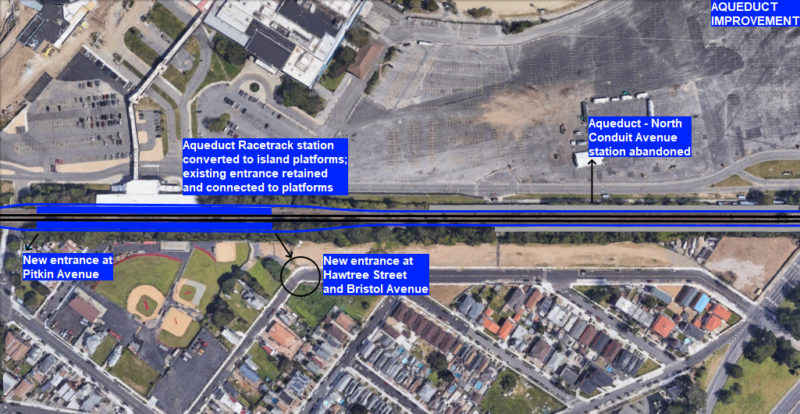UPDATE (10.19.2022): Post revised to reflect v1.0.0 v0.8.0 of the enhanced NYC subway.
Welcome to my ongoing NYTIP series! Recall my three-point plan to fix the NYC Subway – enhance, extend, and expand. In this post, I will address “low-hanging fruit” opportunities to enhance the NYC Subway.
Point one – enhance – addresses subway improvements using existing infrastructure; hence, I focused on de-interlining. However, there are other ways to use existing infrastructure to improve subway service.
I. Infill Stations
10th Avenue – 41st Street
One of the most obvious candidates for an infill station is the planned – but unbuilt – 10th Avenue station on the 7 line extension. This station would serve Manhattan’s bustling Hell’s Kitchen neighborhood. Though the only evidence of a planned station is a change in the tunnel profile from curved to straight, it is still feasible to build it. Given the immense benefits such a station would provide, v0.8.0 of the enhanced NYC subway under NYTIP would include the 10th Avenue – 41st Street station.
Leveraging Subway Yards
Consider the Harlem – 148th Street terminal on the 3 line. This is an example of an infill station built within a storage yard. Are there other yards where this treatment would be beneficial? Let’s take a look.
Pitkin Yard
This yard is located due southeast of the Euclid Avenue station. Its location is ideal for an infill station since it is surrounded by apartment complexes – one of which sits directly atop the yard. The Linden Boulevard Multiplex and the Brooklyn General Mail Facility are each located a short distance away. An infill station could be built on the yard’s west side, as shown in the figure below.
[Fig. 1] Overview of the Linden Plaza infill station at Pitkin Yard.
In v0.8.0 of the enhanced NYC subway under NYTIP, the Linden Plaza station would be served by E trains. The station would have an entrance on the north side of Linden Boulevard just east of Lincoln Avenue; if feasible, additional entrances could be built on the south side of Linden Boulevard, as well as the intersection of Lincoln and Dumont Avenues.
Based on the benefits such a station would provide, v0.8.0 of the enhanced NYC subway under NYTIP would include the Linden Plaza station.
Jamaica Yard
Under NYTIP, the R train runs to Jamaica – 179th Street. This partially relieves congestion at the existing Forest Hills – 71st Avenue terminus. However, with M trains terminating at Forest Hills, congestion could still occur. One possible mitigation is constructing an infill station within Jamaica Yard, as shown in the figures below.
[Figs. 2, 3] Overview of the Kew Gardens Hills infill station at Jamaica Yard.
Subway service through Jamaica Yard is not unprecedented – a short-lived connection to Flushing Meadows via Jamaica Yard once existed to serve the 1939 World’s Fair; the Van Wyck Expressway alignment approximates the former track location. Since Jamaica Yard is surrounded by highways and not easily accessible, the proposed station would be on the yard’s east side. This station requires several elements – an overpass over the Van Wyck, new crosswalks at 77th Avenue and Park Drive East, and an entrance where no sidewalks currently exist. Thankfully, existing traffic calming measures make this arrangement possible with minimal disruption. When combined with R service to 179th Street, this extension provides significant relief at Forest Hills, allowing local service increases on the Queens Boulevard corridor.
Another proposal that increases Queens Boulevard local service is the QueensLink. If built, the QueensLink would send the M train via the Rockaway Beach branch and extend the G train via Queens Boulevard to replace the M. In this scenario, the G would serve the Kew Gardens Hills station. Aside from introducing a new merging conflict, there is insufficient rolling stock to extend the G in this manner. Therefore, v0.8.0 of the enhanced NYC Subway under NYTIP would not include the Kew Gardens Hills station. The forthcoming R211 order could mitigate the rolling stock issue, especially as it relates to QueensLink, which I fully support.
Options No Longer Considered
In previous versions of this post, I explored possible infill stations at the Concourse Yard in The Bronx and Livonia Yard in Brooklyn. Since the Concourse Yard routing is circuitous and the Livonia Yard routing stops short of the Gateway Center mall due south, I am no longer considering either option.
Aqueduct Racetrack
The Aqueduct Racetrack and Aqueduct – North Conduit Avenue stations are very close together, and the former only serves northbound trains. To improve A train service with minimal inconvenience:
Build island platforms at Aqueduct Racetrack, and abandon the North Conduit Avenue station.
[Fig. 4] Overview of the proposed Aqueduct improvement.
Originally, I proposed a southbound side platform at Aqueduct Racetrack. However, converting Aqueduct Racetrack to island platforms allows for future QueensLink integration without merging conflicts.
The converted station retains the existing entrance to Resorts World and adds two new entrances – one at Pitkin Avenue and one at Hawtree Street; the latter obviates the need for the North Conduit Avenue station. These changes result in a slight speed improvement for A train riders on the Rockaway line.
II. The Canal Street Flip (deprecated)
[Fig. 5] Overview of the Canal Street Flip, a.k.a. Canal Flip.
The Canal Flip dates back to the 1999 Manhattan East Side Transit Alternatives Study (MESA). The Regional Plan Association’s Save our Subways publication also explores the Canal Flip. The Canal Flip is a capital investment that would’ve rerouted Broadway express trains via Lower Manhattan as an alternative to the Lex, while sending Broadway local trains over the Manhattan Bridge. Given the revamped South Brooklyn redesign for v0.8.0 of the enhanced NYC subway, the Canal Flip is no longer under consideration.
III. Platform Straightening
Several stations sit on curves – some of them so tight that they leave large gaps.
One infamous example is 14th Street – Union Square on the Lex, which uses gap fillers to bridge the gaps between trains and platforms. Recently, the Union Square Partnership released a plan to expand Union Square; naturally, this led to a question regarding platform straightening:
This wouldn’t be the first time the MTA embarked on a platform straightening project; the recently-completed 42nd Street Shuttle improvement is one such project. However, there are other stations with dangerous gaps – mostly in the South Bronx on the IRT White Plains Road line – which I will now discuss.
West Farms Square – East Tremont Avenue
Not only does this station sit on a curve, but trains approaching this station from either direction must negotiate other curves; the curve from the north is especially sharp. Straightening this station requires a structural realignment. The following figure shows one way to accomplish this.
[Fig. 6] West Farms Square realignment.
Part of the new structure would encroach onto NYCHA property, but this only affects a small part of an outdoor plaza and not the buildings.
Some time go, vanshnookenraggen proposed going even further – straightening the line to remove the sharp curve entirely. Such a change requires a few property takings, but as the main casualty appears to be a parking lot, I have no problem with it.
[Fig. 7] West Farms Square realignment with right-of-way (ROW) straightening.
174th Street, Freeman Street, and Jackson Avenue Stations
Unlike West Farms Square station, platform straightening at these three stations does not require a structural realignment. Instead, straight platform extensions can replace the curved segments, as follows:
[Figs. 8, 9, 10] Platform straightening at 174th Street, Freeman Street, and Jackson Avenue stations, respectively.
Each platform straightening affords opportunities to construct new entrances and implement ADA upgrades, enhancing safety and encouraging ridership.
IV. Other Improvements
Here are additional examples of low-hanging fruit.
Broadway Station (Brooklyn) and Marcy Avenue Station
The Broadway El (J/M) and Crosstown (G) lines intersect each other, but offer no transfers between them. In previous versions of this post, I considered two options – consolidating the Hewes Street and Lorimer Street stations, or building an in-system transfer at Hewes Street:
[Fig. 11] Overview of the Union Avenue – Broadway station.
[Fig. 12] Overview of the Hewes Street – Broadway in-system transfer. The white arrows show approximate locations of some closed entrances to the Broadway (G) station.
Recently, I’ve begun exploring ideas for improving the Broadway – Myrtle Avenue corridor. Let’s just say I have bigger plans for this corridor. Thus, in the near term, v0.8.0 of the enhanced NYC subway under NYTIP would incorporate an out-of-system transfer between the Broadway and Hewes Street stations.
An optional enhancement for J and M service in Brooklyn is reconstructing Marcy Avenue station with island platforms, as follows:
[Fig. 13] Optional Marcy Avenue island platform conversion.
This conversion would improve peak-directional J express service and significantly improve passenger circulation through the station. The Havemeyer Street entrance would bring riders closer to the Washington Plaza bus hub at the foot of the Williamsburg Bridge.
Final Thoughts
Now, I’d be remiss if I didn’t mention the closed entrances systemwide. An obvious improvement is one echoed by other advocates:
Reopen closed entrances systemwide, and accelerate full ADA accessibility.
This is the ultimate low-hanging fruit in the NYC Subway. Reopening closed entrances would increase the subway’s reach and encourage ridership. Full ADA accessibility would do the same.
Taken together, this is the low-hanging fruit of NYC Subway expansion and improvement. These ideas – almost all of which use existing infrastructure – would improve travel for many subway riders.














For the Canal St flip, how would yard access for the Broadway express work? I’m assuming your plan for South Brooklyn would have to go into effect?
Also, if done, would there still be need for a full 2 Av line from Harlem to Hanover Square? I feel like with this and extending the MNR Harlem to Lower Manhattan (and Staten Island one day, God willing) as part of regional rail would be sufficient. I guess it will all depend on how WFH affects ridership if it becomes a long-term thing.
My enhanced NYC subway forms the basis for my extension/expansion posts, so yes, my SBK plan would be in effect.
Post-Canal Flip, I envision yard assignments as follows:
N: Jamaica and CI (mostly at Jamaica)
Q: CI (you could stage some put-ins at City Hall LL or the CPW-SAS connection just outside St. Nicholas/125 if needed)
R: Con-Ed storage yard in Astoria
In my view, you wouldn’t need a full-length SAS that ends at Hanover if you do Canal Flip. I still think such could be useful, but only if it serves The Bronx and/or Brooklyn, and only if built in a way that doesn’t interfere with the Broadway service.
Regional rail would indeed be a boon! I’ll get to that at some point in this series.